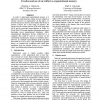Free Online Productivity Tools
i2Speak
i2Symbol
i2OCR
iTex2Img
iWeb2Print
iWeb2Shot
i2Type
iPdf2Split
iPdf2Merge
i2Bopomofo
i2Arabic
i2Style
i2Image
i2PDF
iLatex2Rtf
Sci2ools
HICSS
2003
IEEE
2003
IEEE
"Yeah, the Rush ain't here yet - Take a break": Creation and Use of an Artifact as Organizational Memory
In order to understand organizational memory, it is important to understand how things become adopted as memory resources in organizations. In this paper, we describe the genesis and use of an artifact that became a memory resource for a wide range of activities. We discuss how the creation and use of the rush cheat sheet (RCS) and its associated representations at Dallas Ft. Worth TRACON brought together information and expert knowledge across organizational boundaries. Multiorganizational information became synthesized in a composite that could be used as a resource by the contributing organizations, acting as a boundary object. However, it is multiple representations of the same data that enable it to be so used. Using distributed cognition theory, we examined the conditions under which data transforms from an internal resource to a boundary object; speculating about domain generalization.
Biometrics | Boundary Object | HICSS 2003 | Memory Resource | Organizational Memory | System Sciences |
| Added | 04 Jul 2010 |
| Updated | 04 Jul 2010 |
| Type | Conference |
| Year | 2003 |
| Where | HICSS |
| Authors | Christine Halverson, Mark S. Ackerman |
Comments (0)

